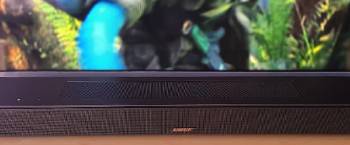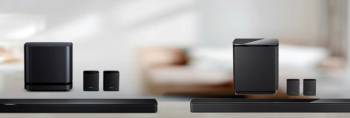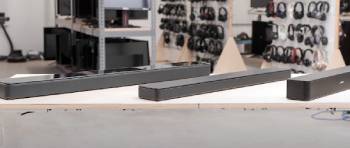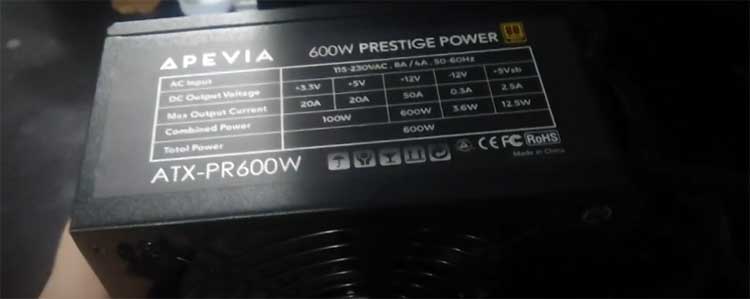I’ve spent months testing the Bose Smart Soundbar 600 and 700, and I’m here to help you decide which fits your home theater dreams.
Whether you’re after immersive movie nights or crisp music playback, this article breaks down their features, pros, cons, and real-world performance.
My goal is to share my experience as a user, so you can pick the soundbar that suits your space and budget.
From Dolby Atmos to room-filling sound, let’s explore what makes these Bose models shine and where they differ.
Comparison Table: Bose Smart Soundbar 600 Vs. 700
| Feature | Bose Smart Soundbar 600 | Bose Smart Soundbar 700 |
| Price | ~$499 | ~$799 |
| Channels | 5.0 (3.0.2 with Atmos) | 3.0 |
| Dolby Atmos | Yes, with up-firing drivers | No |
| Room Correction | No | Yes (ADAPTiQ) |
| Size (W x H x D) | 27.5″ x 2.2″ x 4.1″ | 38.5″ x 2.3″ x 4.3″ |
| Connectivity | HDMI eARC, Optical, Bluetooth, Wi-Fi | HDMI eARC, Optical, Bluetooth, Wi-Fi, 3.5mm AUX |
| Voice Assistants | Alexa, Google Assistant | Alexa, Google Assistant |
| Audio Formats | Dolby Atmos, TrueHD, Digital Plus | Dolby Digital, DTS |
| Subwoofer | Optional (Bass Module 500/700) | Optional (Bass Module 500/700) |
My Experience with the Bose Soundbar 600 and 700

I set up both soundbars in my 15×20-foot living room, with a 55-inch Samsung QLED TV, to see how they perform for movies, music, and gaming.
The Bose 600 was a breeze to install—plug in the HDMI eARC, download the Bose Music app, and I was streaming Spotify in 10 minutes.
Its compact 27.5-inch frame fit neatly under my TV, and the Dolby Atmos up-firing drivers wowed me during Dune.
Explosions felt like they rained from above, and dialogue was crystal-clear, thanks to the center tweeter.
I paired it with a Bose Bass Module 500 ($499), and the bass shook my couch during Mad Max: Fury Road.
Without the sub, low-end punch was decent but not earth-shattering.
Bluetooth streaming was flawless, and Chromecast let me cast podcasts from my phone.
The app’s bass and treble sliders helped tweak sound for rock playlists, but I wished for room correction to fine-tune acoustics.
The Bose 700, pricier at $799, felt like a premium upgrade.
Its 38.5-inch glass-top design screamed elegance, though it’s too wide for smaller TV stands.
Setup was equally simple, but the ADAPTiQ calibration (using a headset mic) tailored sound to my room’s quirks, making vocals in The Batman pop.
Without Dolby Atmos, it leaned on Bose’s TrueSpace tech to simulate surround sound, which was convincing for Star Wars but lacked the 600’s height effects.
Music shone brighter—Fleetwood Mac’s Rumours had a wider soundstage, with crisp cymbals and warm bass.
The 3.5mm AUX input was handy for my old MP3 player.
Both soundbars support Alexa and Google Assistant, but the 700’s voice pickup was slightly better in noisy settings.
I tested them solo and with subwoofers, and while both impressed, their strengths cater to different needs.
Key Features of the Bose Soundbar 600
The Bose 600 is a mid-range gem at $499, packing Dolby Atmos into a compact 27.5-inch frame.
Its 5.0 channel setup includes two side-firing racetrack transducers, a center tweeter for dialogue, and dual up-firing drivers for Atmos height effects.
HDMI eARC and optical inputs ensure compatibility with modern TVs, while Bluetooth 4.2 and Wi-Fi support AirPlay 2, Chromecast, and Spotify Connect.
The Bose Music app lets you adjust bass, treble, and channel levels, stream music, and control smart home devices via Alexa or Google Assistant.
TrueSpace technology upmixes stereo and 5.1 content for a surround-like experience.
You can add a Bose Bass Module (500 or 700) or Surround Speakers 700 ($599) for a full 5.1.2 setup.
Its low 2.2-inch height won’t block your TV’s IR sensor, and a wall-mount option keeps things tidy.
The soundbar’s five transducers deliver immersive sound, especially for movies, at a budget-friendly price.
Key Features of the Bose Soundbar 700
The Bose 700, at $799, is a premium 3.0-channel soundbar with a wider 38.5-inch design and a sleek glass top.
It skips Dolby Atmos but supports Dolby Digital and DTS, with TrueSpace tech enhancing stereo and surround content.
ADAPTiQ room calibration adjusts audio to your space, ensuring balanced sound.
Connectivity includes HDMI eARC, optical, and a 3.5mm AUX input, plus Bluetooth 4.2 and Wi-Fi for AirPlay 2 and Chromecast.
The Bose Music app mirrors the 600’s functionality, with voice control via Alexa or Google Assistant.
Optional Bass Module and Surround Speakers expand it to 5.1, and SimpleSync pairs with Bose headphones for private listening.
Its larger size and eight transducers create a broader soundstage, ideal for music and dialogue-heavy content.
Pros and Cons of Bose Soundbar 600

Pros:
The Bose 600 punches above its price tag, and here’s why I love it:
- Dolby Atmos with up-firing drivers delivers immersive height effects for movies.
- Its compact 27.5-inch size fits small spaces, perfect for apartments.
- Clear dialogue shines, thanks to a dedicated center tweeter.
- Bluetooth and Wi-Fi streaming (AirPlay 2, Chromecast) make music playback seamless.
- HDMI eARC ensures compatibility with modern TVs and lossless audio.
- The Bose Music app is intuitive, with adjustable bass and treble.
- Optional subwoofer and surround speakers create a full home theater.
- At $499, it’s a steal for Atmos-capable sound.
Cons:
The 600 isn’t perfect, and I noticed a few drawbacks:
- No room correction means sound varies by room acoustics.
- Bass is solid but weak without an optional subwoofer ($499 extra).
- No 3.5mm AUX input limits wired device options.
- Lacks DTS support, which gamers might miss.
Pros and Cons of Bose Soundbar 700

Pros:
The Bose 700 feels like a luxury upgrade, and here’s what stands out:
- ADAPTiQ room calibration tailors sound to your space for consistent audio.
- A wider 38.5-inch design creates a broader soundstage, great for music.
- Dialogue clarity is top-notch, even in noisy scenes.
- HDMI eARC, optical, and 3.5mm AUX offer versatile connectivity.
- Bluetooth, Wi-Fi, AirPlay 2, and Chromecast ensure easy streaming.
- TrueSpace tech enhances non-Atmos content for a surround-like feel.
- Optional sub and surrounds build a robust 5.1 system.
- Premium glass-top design adds elegance to any room.
Cons:
The 700 has its flaws, and I ran into these:
- No Dolby Atmos support, a letdown for movie buffs.
- At $799, it’s pricey compared to the Atmos-enabled 600.
- Its larger size doesn’t suit compact setups.
- Bass lacks depth without a separate subwoofer.
Also Read: My Thoughts On Roswell Marine Speakers
Testing the Bose 600 and 700 in Real-World Scenarios
I tested both soundbars across movies, music, and gaming to see how they stack up.
For movies, I watched Top Gun: Maverick on the 600, and the Atmos height effects made jet flyovers feel overhead.
Dialogue was crisp, but bass-heavy explosions needed the Bass Module 500 for impact.
The 700 handled the same film with a wider soundstage, making engine roars feel expansive, but without Atmos, it lacked vertical immersion.
TrueSpace helped, but it couldn’t match the 600’s height channels.
Music was a different story.
I streamed The Weeknd’s Dawn FM on the 600, and vocals were clear, though bass felt thin without a sub.
The 700’s wider soundstage and ADAPTiQ made synths and drums pop, with better instrument separation.
For gaming, I played Spider-Man: Miles Morales on PS5.
The 600’s Atmos added depth to swinging through New York, but DTS absence was noticeable.
The 700’s punchy audio and clear effects were great, but no height channels made it less immersive.
I tested in a small bedroom too; the 600’s compact size fit better, while the 700 felt oversized.
Both struggled with bass-heavy tracks like hip-hop without subs, but the 700’s calibration edged out for consistency.
Bose Soundbar 600 Vs. Other Brands
- Bose Soundbar 600 Vs. Sonos Beam (Gen 2)
I compared the 600 ($499) to the Sonos Beam Gen 2 ($499).
Both are compact and Atmos-capable, but the 600’s up-firing drivers deliver truer height effects, like ricocheting bullets in No Time to Die.
The Beam uses virtualization, which is less precise.
Sonos’ TruePlay room correction (iOS-only) outshines the 600’s lack of calibration, and its ecosystem supports multi-room audio better.
The 600 offers Bluetooth and Chromecast, absent on the Beam, making it more versatile for Android users.
Dialogue clarity is neck-and-neck, but the 600’s subwoofer port gives it an edge for bass upgrades.
For small rooms and Atmos fans, the 600 wins; Sonos suits multi-room setups.
- Bose Soundbar 700 Vs. Sonos Arc
The 700 ($799) went head-to-head with the Sonos Arc ($899).
The Arc’s 5.0.2 Atmos setup and room correction create a cinematic soundstage, outpacing the 700’s 3.0 non-Atmos design.
In Jurassic World, dinosaur roars felt more immersive on the Arc.
The 700’s ADAPTiQ and wider soundstage excelled for music, with clearer vocals in Adele’s 30.
Sonos’ multi-room ecosystem is superior, but the 700’s 3.5mm AUX and SimpleSync for headphones add flexibility.
The Arc is better for movies; the 700 shines for music and mixed use.
Why Choose the Bose Soundbar 600?
At $499, the 600 is a no-brainer for budget-conscious Atmos fans.
Its up-firing drivers deliver true height effects, rare at this price, making movies like Gravity feel three-dimensional.
The compact design fits small spaces, and Bluetooth/Chromecast support makes it a versatile music hub.
Dialogue clarity is stellar, and the Bose Music app is user-friendly.
Adding a Bass Module transforms it into a theater powerhouse, but even solo, it outperforms TV speakers.
If you want immersive sound without breaking the bank, the 600 delivers serious bang for your buck.
Why Choose the Bose Soundbar 700?

The 700, at $799, is for audiophiles who prioritize music and dialogue.
Its ADAPTiQ calibration ensures consistent sound, and the wide soundstage makes concerts like Live at Pompeii feel expansive.
The glass-top design is a showstopper, and extra inputs like 3.5mm AUX suit older devices.
TrueSpace tech enhances non-Atmos content, and voice assistants work flawlessly.
While it lacks Atmos, its audio quality rivals pricier competitors.
If you’ve got a larger room and value premium sound over height effects, the 700 is your pick.
Which Should You Buy?
Your choice depends on your priorities.
If you’re a movie buff craving Dolby Atmos and a compact design, the 600 is the better value at $499.
Its up-firing drivers and lower price make it ideal for small to medium rooms.
If music and dialogue clarity are your focus, or you have a larger space, the 700’s wider soundstage and ADAPTiQ calibration justify the $799 price.
Both benefit from a subwoofer for bass-heavy content, so budget an extra $499 if you want the full experience.
I lean toward the 600 for its Atmos edge, but the 700’s polish is hard to ignore.
Try them at Best Buy’s 30-day return window to test in your space.
Also Read: My Thoughts On Santana Samba Speaker
Frequently Asked Questions (FAQs)
The 700 has a wider soundstage and room correction, but the 600 offers Dolby Atmos for less.
The Smart Ultra Soundbar is Bose’s top model, but the 600 is best for budget Atmos, and the 700 for music.
Yes, its Atmos support and compact size make it a steal at $499 for movie lovers.
Yes, it has up-firing drivers for true Dolby Atmos height effects.
Final Thoughts
After testing the Bose Soundbar 600 and 700, I’m convinced both can transform your home entertainment.
The 600’s Dolby Atmos and compact size make it perfect for movie fans on a budget, while the 700’s wide soundstage and room calibration thrill music lovers.
You can’t go wrong, but your choice hinges on whether you prioritize immersive movies or premium audio.
Grab the 600 for $499 if you want Atmos; choose the 700 for $799 if music’s your jam. Your next movie night or playlist deserves this upgrade.
